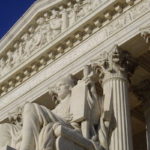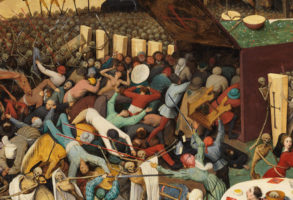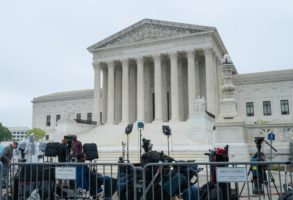Published July 29, 2016
National Review - August 1, 2016 issue
Review: The Burger Court and the Rise of the Judicial Right, by Michael J. Graetz and Linda Greenhouse (Simon & Schuster, 480 pp., $30)
By the standards of judicial conservatives, the so-called Burger Court — the Supreme Court presided over by Chief Justice Warren E. Burger from 1969 to 1986 — earns lots of poor marks. That Court invented, among other things, a supposed constitutional right to abortion in Roe v. Wade in 1973; struck down all existing death-penalty laws and then concocted a morass of confused standards to govern newly enacted laws on capital punishment; and paved the way for massive racial preferences by failing to give effect to federal statutes that bar discrimination on the basis of race. More broadly, the Court frequently adopted vague balancing tests that could be deployed to reach a broad range of results.
Law professor Michael J. Graetz and legal commentator Linda Greenhouse have a very different beef, so to speak, with the Burger Court, and they grind their beef throughout their sometimes interesting, sometimes tedious book. They claim that the Burger Court enjoyed much more success than has been realized in carrying out a “counterrevolution” against the historic liberal activism of the Court under Burger’s predecessor, Earl Warren. They also contend, as the second half of their title suggests, that the Burger Court “played a crucial role in establishing the conservative legal foundation” for what they label “the even more conservative Courts that followed.”
As these passages indicate, Graetz and Greenhouse write from an unabashedly liberal perspective. I don’t mean that observation necessarily as a criticism: It would be difficult to evaluate the Burger Court without adopting some fixed perspective, and their joint effort is, for the most part, much less tendentious than Greenhouse’s usual output. But like many advocates of the freewheeling “living Constitution” approach, they seem to suppose that their ideological preferences are some sort of substitute for constitutional interpretation. We’re told, for example, that the “overarching theme” of their iconic Warren Court “was equality” and that “no such lodestar drew the Burger Court,” but they offer little or nothing in the way of constitutional analysis to enable the reader to assess, or even to think about, whether one Court was more faithful to the Constitution than the other was.
There is no dispute that the Burger Court changed course from the Warren Court in many respects, perhaps most markedly on matters of criminal procedure. But straining to support their more ambitious theses, Graetz and Greenhouse marshal and assess the Burger Court’s cases in a makeshift manner. When the Burger Court issued liberal rulings they like, it’s because “the American people forced the Court to accept, and in some cases even endorse, massive shifts in public opinion and conduct.” But when they don’t like the rulings, it’s “the ideological commitments of the justices [that] forced a transformation of constitutional doctrine.” And they entirely ignore some big progressive victories they can’t explain away, such as the Court’s 1982 ruling that the equal-protection clause requires states to extend their systems of free public education to the children of illegal aliens.
Their treatment of Roe and of the Court’s later rulings rejecting any constitutional right to funding of abortion is particularly striking. Much as they welcome Roe, they are stingy in giving the Burger Court any credit for it; “strong historical forces” are instead responsible. Worse, they complain that, given the funding rulings, the right to abortion ended up being only “a negative right: not a right to anything but a right against something, the right not to be prosecuted for performing an abortion or obtaining one” (emphasis in original). The unreflective reader is unlikely to recognize that, in the classical-liberal tradition, the Constitution has been widely understood to confer only such “negative” rights. The First Amendment right to free speech, for example, does not include a right to have the government fund your speech. So why would the (entirely atextual and contrived) right to abortion be any different?
Graetz and Greenhouse attack a 1972 victory for Amish parents as “one of the strangest and . . . most problematic” rulings about the free-exercise clause of the First Amendment. But they don’t see fit to highlight the fact that William Brennan and Thurgood Marshall, the great liberal lions of the Warren Court (both of whom went on to outlast Burger), voted with the majority and that the ruling, far from setting a “high-water mark” for religious-liberty rights, applied the very standard Brennan had set forth nine years earlier. Anyone familiar with Greenhouse’s barrage of misguided attacks on the Little Sisters of the Poor and others challenging the Obama administration’s contraception mandate will have ample reason to suspect that her current agenda is warping the authors’ judgment.
Was there, in any meaningful sense, ever really a Burger Court at all? It’s conventional to divvy up Supreme Court history into periods corresponding to the tenure of the chief justices and to name each period after the chief justice. But that convention can have the misleading effect of overstating the chief’s influence. In deciding cases, the chief justice has the same lone vote as any other justice, and what special powers he has, such as the ability to pick who will write the lead opinion for the Court when he is part of the majority, don’t confer much leverage. Unless four other justices can be counted on to join him — a situation that hasn’t existed since Earl Warren’s retirement in 1969 — the chief justice won’t have a working majority that would enable him to define the trajectory of the Court.
Warren Burger took the helm of a Court on which he was the most conservative justice. To be sure, within his first three years as chief, he was joined by three other Nixon appointees: his childhood friend Harry A. Blackmun, corporate lawyer Lewis F. Powell Jr., and the man who would succeed him as chief, William H. Rehnquist. But as Blackmun moved left and Powell joined Potter Stewart and Byron R. White in the Court’s center, Burger had to compete with the much craftier Brennan to compile a majority. The later additions to the Court — Ford appointee John Paul Stevens in 1975 and Reagan pick Sandra Day O’Connor in 1981 — were each somewhat more conservative, at least during Burger’s tenure, than the justices they replaced (William O. Douglas and Stewart, respectively), but Burger never enjoyed a reliable majority for his positions.
Nor is it evident that Burger had a consistent methodology or approach that underlay his various positions (which included joining Blackmun’s majority opinion in Roe while contesting that it meant what it seemed to say). Insofar as Graetz and Greenhouse credit the Burger Court for the “rise of the judicial Right,” they seem to misunderstand the nature of any causal relationship. I would submit that conservative advocacy of the methodology of constitutional originalism, by the likes of Robert Bork, Antonin Scalia, and Ed Meese, and the establishment of the Federalist Society in the early 1980s were much more a reaction against the intellectual aimlessness of the Burger Court than they were a positive outgrowth of that Court’s work. Thus, the best marker of the (alas, far from triumphant) “rise of the judicial Right” may well be President Reagan’s appointment of Scalia to the Court upon Burger’s retirement (and Rehnquist’s elevation) 30 years ago.
– Mr. Whelan, the president of the Ethics and Public Policy Center, is a regular contributor to National Review Online ’s Bench Memos blog.









